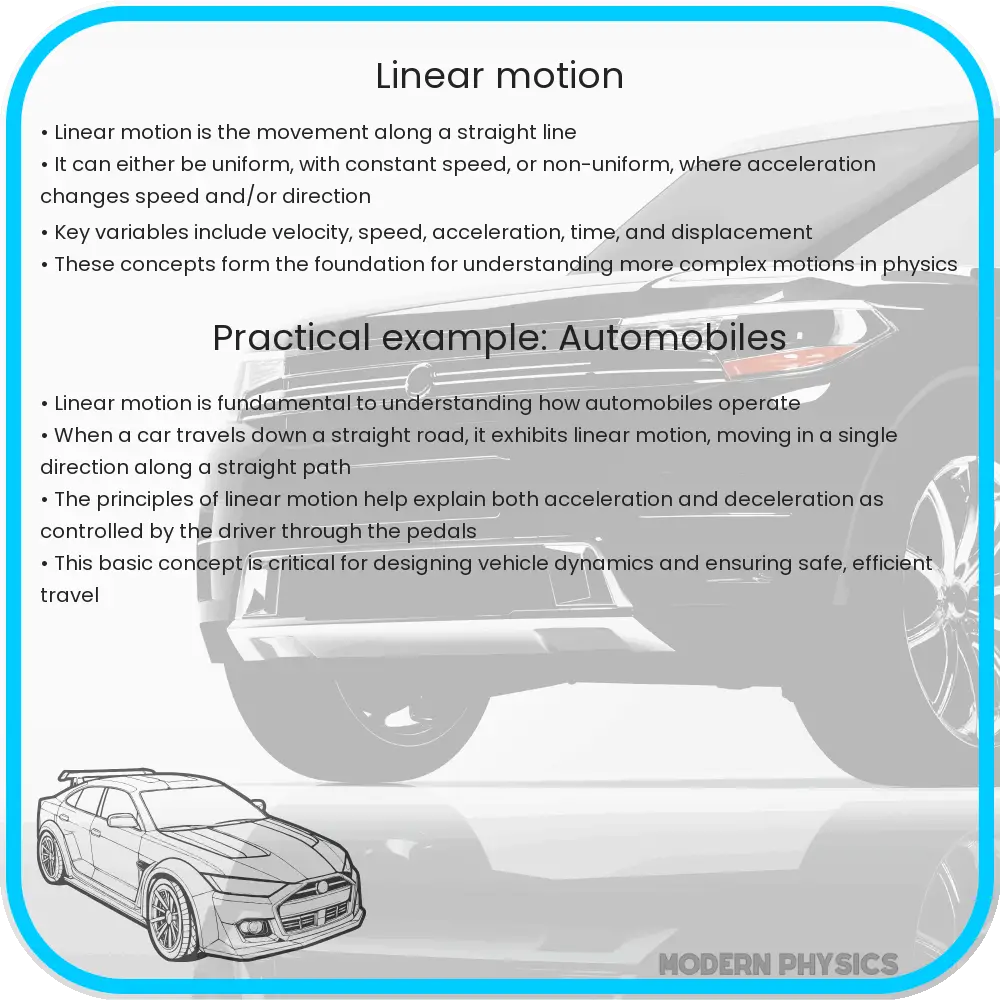Explore the essentials of linear motion in kinematics, covering principles, equations, and real-world applications in engineering and physics.

Understanding Linear Motion in Kinematics
Linear motion, a fundamental concept in the study of kinematics, refers to the motion of an object along a straight path. This type of motion is paramount in understanding the basics of mechanics and physics. In this exploration, we’ll delve into the principles and equations that govern linear motion, providing a comprehensive understanding suitable for students and enthusiasts alike.
Principles of Linear Motion
Linear motion is governed by three core principles: velocity, acceleration, and displacement. These elements are interrelated and essential in characterizing an object’s motion.
- Displacement (s): It represents the change in position of an object. Unlike distance, displacement is a vector quantity, meaning it has both magnitude and direction. It’s calculated as the final position minus the initial position.
- Velocity (v): This is the rate at which an object changes its position. It’s a vector quantity, represented as displacement per unit time. The formula for average velocity is v = s/t, where ‘s’ is displacement and ‘t’ is the time taken.
- Acceleration (a): Acceleration is the rate of change of velocity. It occurs when an object speeds up, slows down, or changes direction. The formula for acceleration is a = Δv/Δt, where Δv is the change in velocity and Δt is the time interval.
Fundamental Equations of Linear Motion
In kinematics, there are several key equations that are used to describe linear motion:
- The Equation of Motion: v = u + at, where ‘u’ is the initial velocity, ‘v’ is the final velocity, ‘a’ is the acceleration, and ‘t’ is the time.
- Displacement in Uniform Acceleration: s = ut + ½at2, a useful equation for calculating displacement when an object is moving with a constant acceleration.
- Velocity-Squared Equation: v2 = u2 + 2as, which relates velocity and displacement in the context of constant acceleration.
These equations are vital in solving various problems in physics, from simple motion to more complex scenarios in engineering and technology. Their applications extend beyond academic pursuits, playing a critical role in the design and analysis of mechanical systems, vehicles, and even space travel.
By understanding the principles and equations of linear motion, one can gain a deeper appreciation for the mechanics of the natural and engineered world. In the next section, we will explore practical applications and real-world examples of linear motion to solidify these concepts.
Practical Applications and Real-World Examples of Linear Motion
Linear motion is not just a theoretical concept; it has practical applications in various fields. Understanding how objects move in a straight line helps engineers and scientists in designing and analyzing systems and structures.
- Transportation: Vehicles such as cars and trains exhibit linear motion when moving on straight paths. Understanding the principles of linear motion helps in optimizing their performance and safety.
- Sports Physics: Athletes and coaches use the principles of linear motion to improve performance. For example, analyzing the linear motion of a sprinter can help in enhancing speed and efficiency.
- Industrial Machinery: Conveyor belts and assembly lines, which move products in a straight line, are designed based on linear motion concepts to ensure efficiency and reliability.
- Space Exploration: Rockets traveling from Earth to space follow a path that, initially, can be approximated as linear motion. Calculations involving linear kinematics are crucial in their design and trajectory planning.
Understanding Kinematics in Everyday Life
Linear motion is not just confined to academic problems but is observable in everyday life. From the motion of a ball thrown straight to the operation of household appliances like sliding doors, linear motion principles are constantly at play. Recognizing these principles in day-to-day activities can enhance one’s understanding of physics and appreciation of the natural world.
Conclusion
In summary, linear motion is a key aspect of kinematics, providing a foundational understanding of how objects move in a straight line. By exploring its principles, equations, and applications, we gain valuable insights into the mechanics that govern both natural phenomena and human-made inventions. From aiding in the design of transportation systems to enhancing athletic performance, the principles of linear motion are integral to numerous fields. As we continue to explore and apply these concepts, they will undoubtedly continue to play a crucial role in technological advancements and our understanding of the physical world.
Whether you are a student, a professional, or simply a curious mind, grasping the fundamentals of linear motion opens up a world of understanding and possibilities, illuminating the elegance and intricacy of motion in our universe.
